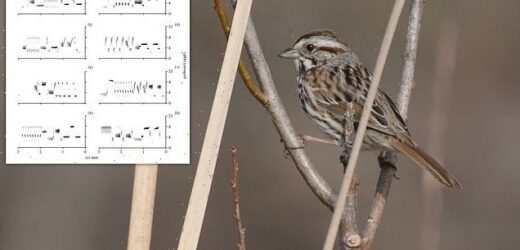Birds create PLAYLISTS to entice a mate! Male song sparrows memorise a 30-minute mix and deliberately shuffle and repeat their tunes to keep a female’s attention, study finds
- Researchers recorded calls from male song sparrows in Pennsylvania woodland
- They found the birds keep tabs on their various performances to avoid repetition
- The clever species can communicate with a complexity akin to human language
Many of us pack our Spotify playlists with an eclectic mix of tunes to keep our party guests entertained.
Now, researchers have revealed that even birds like to mix things up with 30-minute-long playlists of their own to help attract a mate.
Biologists recorded the distinctive birdsong of male song sparrows (Melospiza melodia) in Pennsylvania to find patterns in their calls.
The males deliberately shuffled their song repertoire, they found, possibly as a way to keep it interesting for their female audience.
The study shows male song sparrows keep track of the order of their songs and how often each one is sung for up to 30 minutes, so they can change up their next 30 minutes of tunes.
Song sparrows are a common songbird throughout North America, but only males sing. They use their song to defend their turf and court mates
SONG SPARROWS
A rich, russet-and-gray bird with bold streaks down its white chest, the Song Sparrow is one of the most familiar North American sparrows.
Its range is continuous from the Aleutians to the eastern US. There’s also an isolated population that lives on the plateau of central Mexico, about 900 miles from the next closest population.
Like many other songbirds, the male uses its song to attract mates as well as defend its territory.
Laboratory studies have shown that the female song sparrow is attracted not just to the song itself, but to how well it reflects the ability of the male to learn.
Source: Cornell University
The new study was led by Stephen Nowicki at Duke University in North Carolina and William A. Searcy at the University of Miami, Florida. They claim song sparrows ‘communicate with the complexity of human language’.
‘Song sparrows cycle through their repertoires significantly more efficiently than would be expected from random sequencing,’ the team say in the paper, published in Proceedings of the Royal Society B.
‘Presumably also, many other general rules may be discoverable in some of the other 4,000 or so species of songbirds.’
Song sparrows are a common songbird throughout North America, but only males sing. They use their song to defend their turf and court mates.
When wooing, they sing up to 12 different two-second songs, a repertoire that can take nearly 30 minutes to get through, since they repeat the same song several times before going on to the next one.
In addition to varying the number of repeats, males also shuffle the order of their tunes each time they sing their back catalogue.
However, it wasn’t known whether males change up their song order and repeats by accident or by design.
To learn more, Searcy loaded up recording gear, trekked out to the backwoods of southwestern Crawford County in Pennsylvania, set up mics pointed to the trees and patiently waited for five hours a day.
‘Adult male song sparrows were recorded on their territories in old fields and forest clearings and along the shores of lakes and waterways,’ Searcy and colleagues explain in the paper.
‘Each subject was recorded on two mornings with a mean of 9.5 days between recording sessions.’
Natural sounds in national parks and gardens really are good for our health, a 2021 study found.
North American experts investigated sound recordings from 251 sites in 66 national parks across the US as part of their study.
They found trickling water improved people’s positive emotions, while bird sounds reduced feelings of stress and annoyance.
Read more: Natural sounds like birdsong are also good for our health, study finds
After recording the full suite of songs from more than 30 birds, the team pored over visual spectrographs of the audio and analysed how often each song was sung and in what order.
Much like a Spotify playlist, the male birds generally sang through their full repertoire before repeating a song, they found.
The researchers also found that the more a sparrow sang a given song, the longer he took to get back to that song, possibly to build up hype and novelty before that song was sung again.
For example, if a male sang ‘Song A’ 10 times in a row, he’d sing even more renditions of his other songs before returning to Song A again.
Alternatively, if Song A was only warbled three times during a set, then a male song sparrow tended to recite a shorter rendition of the rest of his repertoire in order to return to Song A.
Taken together, these findings demonstrate that song sparrows possess an extremely rare talent known as ‘long-distance dependencies’, where one element affects choice of another occurring considerably later.
In other words, it means that what a male song sparrow sings in the moment depends on what he sang as much as 30 minutes ago.
Pictured, a song sparrow (Melospiza melodia) calling while perched on a tree stump in Pennsylvania, US
At 30 minutes, male song sparrows have a 360 times larger memory capacity than the previous record holder, the canary, which can only juggle about five seconds worth of song information in this way.
It remains to be seen whether better shuffling ability gives males an advantage at finding love, however.
It’s possible females maintain interest in a mate who mixes it up more, and are less likely to go off with another male.
Future research could test this by comparing birdsong data with paternity tests of chicks laid by a female song sparrow, according to the team.
ABOUT 8 OUT OF 10 OF BRITAIN’S MOST POPULAR SONGBIRDS ARE IN DECLINE: RSPB
Nearly 80 per cent of Britain’s most popular songbirds are in decline, the RSPB warned in 2021 after its biggest-ever Big Garden Birdwatch.
The world’s biggest wildlife survey found that 16 out of the 20 most spotted garden birds faced a decline in numbers on the previous year.
More species currently face decline than in 2020, when half the birds in the top 20 saw falling numbers, the conservation charity announced.
Over a million wildlife enthusiasts counted 17 million birds in their garden in one hour on the last weekend in January 2021 – double the number of people who took part in the charity’s enormous birdwatch in 2020.
The study found that the house sparrow remained number one, but 16 out of the top 20 bird species showed declines in average counts on last year.
The Big Garden Birdwatch takes place annually and relies on the public recording the number of bird species visiting their gardens or balconies for one hour.
This year’s Big Garden Birdwatch takes place between today, Friday 28 January, and Sunday 30 January.
Source: Read Full Article




